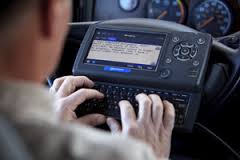 Electronic Logging Device / EOBR - Motor Carrier Regulation Expert Witness
Electronic Logging Device / EOBR - Motor Carrier Regulation Expert Witness
What defines these truck driver logging devices?
AOBRD:
This is the language used in the current FMCSA regulation for Hours Of Service (HOS) compliance (FMCSA 395.15) recording using an electronic device in lieu of paper logs. AOBRDs is the correct terminology when referring to technology regulated in 49 CFR 395.15.
EOBR:
This term has been used in the Trucking industry for over a decade and refers to a software driven device that records an electronic log. The FMCSA used the EOBR term in the 2010 Rule – 395.16, which was vacated in August of 2011.
What Are Electronic Logging Devices (ELDs)?
According to the rule, ELDs are required to automatically: record a commercial driver's Hours of Service (HOS) and Records of Duty Status (RODS). These devices are a combination electronic, electro-mechanical, or mechanical device capable of recording and reporting RODS status information automatically. (49 CFR §395.15). The device must be integrated into the operation of the commercial motor vehicle (CMV) in which it is installed.
The minimum requirement for integration includes:
- Engine hours
- Road speed
- Miles driven
- The date and time of day
However, additional information must also be readily available from the device including:
- Driver Duty Status: “Off duty”, “Sleeper berth”, “Driving” or “On-duty not driving”. These statuses may also be indicated by a code.
- Location of the Tractor when a duty status changed
- Date & time of events and changes in Duty Status
- Total miles driving today
- Truck or tractor and trailer identification information
- Motor Carrier information including: Carrier name and main address
- 24-hour period starting time
- Name of co-driver (if any)
- A summary of hours in each duty status for the last 24 hours
- Shipping document numbers and/ or name of shipper and cargo.
When Will ELDs be Required?
Unfortunately this is a moving target. In Late February of 2015 the FMCSA delayed the publication date for the ELD mandate to November 9,2015. However the FMCSA back tracked from the February 2015 change and has indicated that it likely publish the final rule on September 30, 2015. Once the rule is implemented it will likely be two years before it is enforced. This gives truck drivers and motor carriers a 24 month time frame to purchase and implement ELDs. However any motor carriers or truck owners that have already invested in an AOBRD or EOBR device installed will have an additional 24 month period to comply.
Can Laptops and Smartphones Considered ELDs?
Laptops, smartphones, tablets and other mobile devices are not considered to be ELDs unless they are connected to the engine to automatically collect the required movement and speed data. The FMCSA specifically addresses these devices in section 395.2: “The device must be integrally synchronized with specific operations of the commercial motor vehicle in which it is installed.At a minimum, the device must record engine use, road speed, miles driven, the date, and time of day.” A phone-based app that has just driver log tracking is not enough to meet HOS tracking requirements. It is possible, however for mobile devices to integrate with the vehicle via a Bluetooth, USB or other connection. Such a connection may allow mobile device apps to be compliant.
What Are The Benefits of Using Electronic Logs?
There are numerous benefits to using electronic logs: 1) Drivers and carriers would see significant time savings from going paperless. Paper logs would be a thing of the past and recording of RODS would be automatic. 2) Drivers would know where they stand HOS wise. Hopefully implementation of ELDs would eliminate the most common logging violations. Drivers would always know their status and whether or not they are in compliance with the rules. ELDs would automatically alert drivers, and perhaps the motor carrier, when they are approaching an HOS limit. These warnings must be delivered to the driver at least 30 minutes prior to an HOS violation. 3) Ease of reporting is another benefit. Auditing would be built into the data collection of RODS at the motor carrier. This would make auditing of driver logs faster and easier. 4) Roadside inspections would be faster and easier as well. Law enforcement would be able to readily determine HOS status thus shortening road side stops. 3) Location of commercial vehicles would also be a benefit. Scheduling and dispatch become much more efficient when home office personnel know the exact location of the vehicles and how much time drivers have available. 5) Better fleet management would be realized. Semi-truck location, engine use, fuel economy speed, and other data captured by the ELDs can greatly improve fleet efficiency. 6) Litigation proceeding will be greatly improved. Drivers and the company may be better protected when the true HOS status be readily obtained by all parties in a CMV legal proceeding.
What Are The Ramifications of an ELD Failure?
If an ELD stops working, the driver must: 1) Properly record the failure of the device. 2) Reconstruct his/her HOS logs for the current day and the previous seven days or back to the point where records are available from the ELD. 3) Switch to manual, handwritten logs until the ELD device is repaired or replaced.
Is Global Positioning System (GPS) data part of what an ELD records?
Yes, GPS data is usually part of what an ELD records. The GPS data may be subject to an audit by the FMCSA or other Law Enforcement agencies. GPS records are considered part of the "supporting documents" for HOS compliance. By law supporting documents must be maintained by the motor carrier for six months. The FMCSA and law enforcement may choose use GPS records to verify the information contained on drivers' logs, even if the motor carrier does not.
Does using an ELD eliminate the drivers’ need to have other documentation?
No, a driver using an ELD must also carry: 1) A basic instruction manual for the use of the ELD. This must include a description of how data is stored and retrieved from the device; 2) Drivers must have a supply of blank paper logs sufficient to record the driver’s duty status and other related information for the duration of the current trip. The paper logs need to be used should the ELD fail. 3) In addition, documents that support or validate the driver’s HOS are required. These include:
- Bills of lading,itineraries, schedules or other documents that show trip origin and destination;
- Dispatch records, trip records or similar documents;
- Expense receipts;
- Electronic mobile communication records sent through fleet management systems;
- Payroll records,settlement sheets or similar documents that show what and how a driver was paid.
As with current Telematic systems and EOBRs, Evidence Solutions is be able to collect and examine ELD records for validation and detection of fraud.
